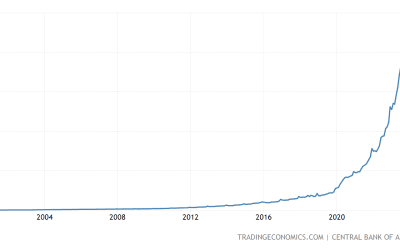It seems that various pro-gold utterances in the course of the Republican primaries have provoked critics of the gold standard to circle their wagons and start shooting. But while the sheer volume of shots fired has been impressive, the shooters’ aim has been lousy.
That goes for this recent volley from EconBrowser’s James Hamilton, in which Professor Hamilton observes, among other things, that
The pre-Fed era was characterized by frequent episodes such as the Panic of 1857, Panic of 1873, Panic of 1893, Panic of 1896, and Panic of 1907 in which even the safest borrowers would suddenly find themselves needing to pay a very high rate of interest. Those events were associated with significant financial failures and business contraction. After establishment of the Federal Reserve, the U.S. short-term interest rate became much more stable and exhibited none of the sudden spiking behavior that used to be so common.
All of this, according to Professor Hamilton, was the fault of the gold standard.
Herewith my comment, minus the typos sullying the hurriedly-composed original as posted on Professor Hamilton’s page:
Though I generally respect Professor Hamilton’s opinions, and do not count myself among advocates of a return to the gold standard, I must say I find the argument he offers here quite disappointing, not the least because it manifests an extreme case of small sample bias of the sort that Professor Hamilton, of all people, might be expected to guard against.
To put the matter bluntly, the pre-Fed financial panics to which the U.S. economy was exposed, along with the general (and especially seasonal) volatility of interest rates during the pre-Fed era, had little if anything to do with the gold standard, as might readily be seen by considering gold-standard countries other than the U.S., and especially (because of its proximity) Canada.
It is notorious, to economic historians at any rate, that both the volatility of U.S. interest rates and the crises to which the U.S. economy was periodically exposed were by products of the “inelastic” nature of the currency system put into place during the Civil War, which (owing to wartime fiscal demands) linked the stock of national bank notes to the outstanding nominal stock of U.S. government securities, while depriving state banks altogether of their right to issue notes. After the war the Treasury enjoyed persistent surpluses, which it used to retire its debt. The transactions costs of acquiring national bank notes from the Comptroller in exchange for requisite bond collateral also made short-run adjustments to the currency stock uneconomical.
In consequence of these circumstances, the U.S. currency stock shrank by 50% between 1880 and 1890, while lacking any capacity for seasonal or cyclical adjustment. This “inelastic” quality of the U.S. currency stock was generally understood to be a major cause both of seasonal and cyclical interest rate volatility and of occasional “currency panics.” This was, indeed, the understanding of the Fed’s founders themselves, who far from claiming that the Fed was needed to defy tendencies stemming from the operation of “the gold standard,” regarded its task as one of allowing that standard to work properly despite the deficiencies of national currency system.
If the gold standard, rather than specific U.S. banking and currency regulations, had been the source of trouble, other gold standard countries should have suffered from the same volatility of interest rates and periodic crises as the U.S. Canada certainly should have, given its high degree of integration with the U.S., which exposed it to similar shocks, including similar gold flows. Instead, Canada was relatively crisis free, and its interest rates were relatively quite “smooth.” The difference wasn’t gold: it was Canadian currency and banking regulations, which among other things allowed Canada’s currency stock to exhibit both secular growth during the last decades of the 19th century, and a lovely “sawtooth” pattern of seasonal adjustment coinciding with harvest-related peaks and troughs in currency demand.
Canada’s relative stability was so notorious back then that many attempts were made in the years prior to 1913 to reform our currency and banking system along Canadian lines. Unfortunately they all failed, largely owing to opposition by the combined forces of Wall Street and the unit bankers’ lobby. The Fed was the compromise solution adopted instead–and a very defective one, as events were to prove.
I’m tempted to complain as well about Professor Hamilton’s failure to distinguish between the unsustainability of that house of cards, the gold exchange standard, and that of a traditional gold standard, and about his failure to note the lengths central banks went to during the 20s to defy the normal workings of the gold standard, by sterilizing gold inflows and so forth, in furthering my claim that he has generally failed properly to identify (I use the word advisedly) the adverse consequences of “the gold standard,” as distinct from those of contemporaneous institutions, but I fear that to go on longer would perhaps be to abuse my privilege of commenting at all.
Originally appeared in freebanking.org




